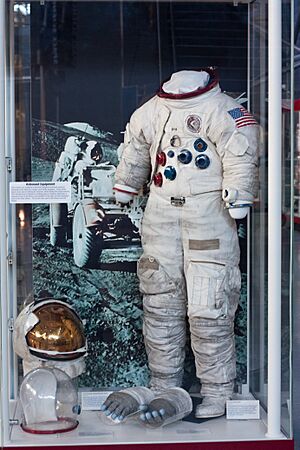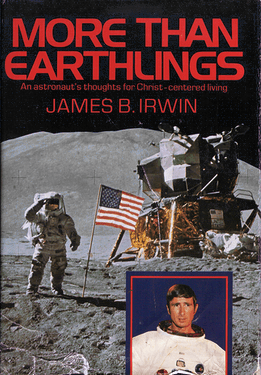James Irwin facts for kids
Quick facts for kids
James Irwin
|
|
|---|---|
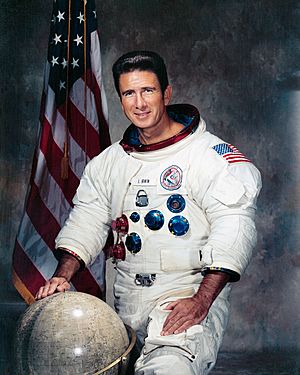
Irwin in 1971
|
|
| Born |
James Benson Irwin
March 17, 1930 Pittsburgh, Pennsylvania, U.S.
|
| Died | August 8, 1991 (aged 61) |
| Resting place | Arlington National Cemetery |
| Other names | Jim Irwin |
| Alma mater |
|
| Occupation |
|
| Awards | |
| Space career | |
| NASA Astronaut | |
| Rank | |
|
Time in space
|
12d 07h 12m |
| Selection | 1966 NASA Group 5 |
|
Total EVAs
|
4 (3 EVAs were on the moon, while his 4th EVA was a stand-up) |
|
Total EVA time
|
18 hours 35 minutes |
| Missions | Apollo 15 |
|
Mission insignia
|
|
| Retirement | July 31, 1972 |
James Benson Irwin (born March 17, 1930 – died August 8, 1991) was an American astronaut, engineer, and test pilot. He was also a United States Air Force pilot. He flew as the pilot of the Apollo Lunar Module for Apollo 15. This was the fourth time humans landed on the Moon. He was the eighth person to walk on the Moon. He was also the first and youngest of those astronauts to pass away.
Contents
Early Life and Education
James Irwin was born on March 17, 1930, in Pittsburgh, Pennsylvania. His family came from Scotland and Ireland. When he was about 12 years old, he told his mother he wanted to go to the Moon. He even thought he might be the first person to do it! (He ended up being the eighth).
He finished high school in Salt Lake City, Utah, in 1947. He then earned a science degree from the United States Naval Academy in 1951. Later, he received two master's degrees from the University of Michigan in 1957. These degrees were in aeronautical engineering and instrumentation engineering.
Military Career
Irwin received his flight training in Texas. He graduated from the Air Force Experimental Flight Test Pilot School in 1961. Before joining NASA, he worked at the Air Defense Command headquarters. During his time in the United States Air Force, he received several important awards. He also flew many different types of planes. He was a test pilot for the Lockheed YF-12, a very fast jet.
In 1961, James Irwin was in a plane crash during a training mission. He and the student pilot survived. Irwin broke several bones and lost his memory for a short time. Doctors helped save his leg, which was badly injured. He spent more than 7,015 hours flying, with 5,300 hours in jet aircraft.
Personal Life
James Irwin grew up in a Christian home. After his trip to space, he became a very devoted Christian. He believed that his faith helped him a lot in his life.
In 1959, Irwin married Mary Ellen Monroe. They stayed married until he passed away. They had five children together: Joy, Jill, James, Jan, and Joe.
NASA Career
NASA chose James Irwin as one of 19 new astronauts in April 1966. He worked on tests for the Apollo Lunar Module in a special vacuum chamber. He also helped support the Apollo 10 mission. This mission was a practice run for the first Moon landing. After that, he was a backup pilot for Apollo 12, the second Moon landing mission.
Apollo 15 Mission
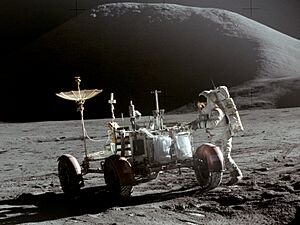
From July 26 to August 7, 1971, James Irwin flew on Apollo 15. He was the lunar module pilot. He spent 295 hours and 11 minutes in space. He also spent 18 hours and 35 minutes walking on the Moon's surface. This was called an extravehicular activity (EVA). Commander David R. Scott also did a short stand-up EVA.
Apollo 15 was different from earlier missions because it focused more on science. Irwin and David Scott received intense training in geology. This extra training helped them make a very important discovery: the Genesis Rock.
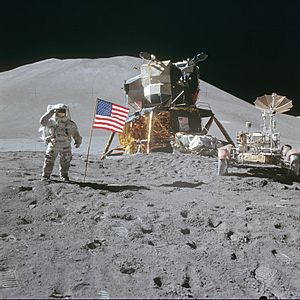
Apollo 15 landed in the Hadley-Apennine area of the Moon. This area is known for its mountains and valleys. They spent almost three days on the Moon. James Irwin was the first person to be a passenger in a car on the Moon! David Scott drove the Lunar Roving Vehicle (LRV). This special car was brought along in the lunar module.
While returning to Earth, doctors on Earth noticed something unusual with Irwin's heart. He and Scott had been working for 23 hours without sleep. They had just finished a moonwalk, left the Moon, and connected with the main spacecraft. A doctor said that if Irwin were on Earth, he would be treated for a heart problem. However, because he was in space with 100% oxygen and zero gravity, he was in the best possible situation. His heart rhythm returned to normal, and he recovered during the rest of the mission.
After NASA
After Apollo 15, there was an issue with some special first day covers (stamps) that the crew took to the Moon. NASA had allowed similar things on earlier flights. However, this time, the astronauts were told they were not allowed to profit from these items. NASA reprimanded the astronauts. James Irwin had already decided to retire from the Air Force and leave NASA before this happened.
After retiring in 1972, James Irwin started the High Flight Foundation. He spent the next 20 years traveling and sharing his Christian faith. He often said that "Jesus walking on the earth is more important than man walking on the moon." He felt that his experience in space made his faith in God even stronger.
Starting in 1973, Irwin led several trips to Mount Ararat in Turkey. He was looking for the remains of Noah's Ark. In 1982, he was hurt during one of these trips and had to be carried down the mountain.
Later Years and Death
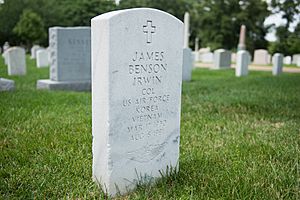
James Irwin had three major heart attacks. The first one happened less than two years after Apollo 15, when he was 43. He had surgery for it. Two months later, he had another heart attack while skiing. On August 8, 1991, he had another heart attack after a bike ride and passed away. He was buried at Arlington National Cemetery.
James Irwin was the first of the 12 men who walked on the Moon to die. The James Irwin Charter Schools in Colorado were named in his honor.
A small piece of a backpack that Irwin left on the Moon during Apollo 15 was later sold at an auction for a lot of money.
Organizations
James Irwin was a member of several groups, including the Air Force Association and the Society of Experimental Test Pilots. He was also a Freemason. He was a member of Civitan International, a group that helps communities and people with disabilities.
Awards and Honors
- Command Pilot Astronaut Wings
- Air Force Distinguished Service Medal
- Two Air Force Commendation Medals
- NASA Distinguished Service Medal
- United Nations Peace Medal, 1971
- City of New York Gold Medal, 1971
- City of Chicago Gold Medal, 1971
- Air Force Association's David C. Schilling Trophy, 1971
- Robert J. Collier Trophy, 1971
- Haley Astronautics Award, 1972
- John F. Kennedy Trophy, 1972
He also received awards from Belgium, the New York Police Department, and other organizations. He received honorary degrees from the University of Michigan, William Jewell College, and Samford University.
He was recognized in the International Space Hall of Fame in 1983. He was also honored in the United States Astronaut Hall of Fame in 1997.
In Media
In the 1998 HBO miniseries From the Earth to the Moon, James Irwin was played by Gareth Williams.
See also
 In Spanish: James B. Irwin para niños
In Spanish: James B. Irwin para niños


